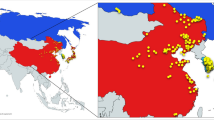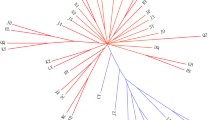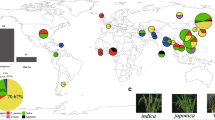Abstract
The knowledge of origin and evolution of cultivated soybeans is one of the basic issues in both biology and agronomy of the crop. In order to investigate the nuclear and cytoplasmic genetic diversity, geographic differentiation and genetic relationship among geographic ecotypes of cultivated (Glycine max) and wild (G. soja) soybeans, the allelic profiles at 60 nuclear simple-sequence repeat (nuSSR) loci and 11 chloroplastic SSR (cpSSR) loci evenly distributed on whole genome of 393 landraces and 196 wild accessions from nation-wide growing areas in China were analyzed. (i) The genetic diversity of the wild soybean was obviously larger than that of the cultivated soybean, with their nuSSR and cpSSR alleles as 1067 vs. 980 and 57 vs 44, respectively. Of the 980 nuclear alleles detected in the cultivated soybean, 377 new ones (38.5%) emerged, while of the 44 chloroplastic alleles in the cultivated soybean, seven new ones (15.9%) emerged after domestication. (ii) Among the cultivated geographic ecotypes, those from southern China, including South-Central China, Southwest China and South China possessed relatively great genetic diversity than those from northern China, while among the wild geographic ecotypes, the Middle and Lower Changjiang Valleys wild ecotype showed the highest genetic diversity. (iii) The analysis of molecular variance, association analysis between geographic grouping and molecular marker clustering and analysis of specific-present alleles of ecotypes demonstrated that the geographic differentiation of both cultivated and wild soybeans associated with their genetic differentiation, or in other words, had their relevant genetic bases. (iv) The cluster analysis of all accessions clearly showed that the wild accessions from Middle and Lower Changjiang Valleys and South-Central & Southwest China had relatively small genetic distances with all cultivated accessions. The UPGMA dendrogram among geographic ecotypes further showed that the genetic distances between all cultivated ecotypes and the Middle and Lower Changjiang Valleys wild ecotype were smaller than those with other wild ones, including their local wild counterparts. Therefore, it is inferred that the wild ancestors in southern China, especially those from Middle and Lower Changjiang Valleys might be the common ancestor of all the cultivated soybeans.
Similar content being viewed by others
References
Doebley J F, Gaut B S, Smith B D. The molecular genetics of crop domestication. Cell, 2006, 127: 1309–1321
Chang R Z. Study on the Chinese soybean germplasm. IV. Variation of plant related traits in different regions (in Chinese). China Seeds, 1990, 34: 10–11
Zhao L M. Studies on chromosome structure aberration of soybean in China (in Chinese). Soybean Sci,1998, 17: 192–197
Abe J, Xu D H, Suzuki Y, et al. Soybean germplasm pools in Asia revealed by nuclear SSR. Theor Appl Genet, 2003, 106: 445–453
Dong Y S, Zhuang B C, Zhao L M, et al. The genetic diversity of annual wild soybeans grown in China. Theor Appl Genet, 2001, 103: 98–103
Pei Y L, Wang L, Ge S, et al. Studies on genetic diversity of Glycine soja isozyme variation in four populations (in Chinese). Soybean Sci, 1996, 15: 302–309
Gai J Y, Xu D H, Gao Z, et al. Studies on the evolutionary relationship among eco-types of G. max and G. soja in China (in Chinese). Acta Agron Sin, 2000, 26: 513–520
Li F S. Study on origin and evolution of soybean (in Chinese). Soybean Sci, 1994, 13: 61–66
Li Z L, Nelson R L. RAPD marker diversity among cultivated and wild soybean accessions from four Chinese provinces. Crop Sci, 2002, 42: 1737–1742
Wang L X, Guan R X, Liu Z X, et al. Genetic Diversity of Chinese Cultivated Soybean Revealed by SSR Markers. Crop Sci, 2006, 46: 1032–1038
Zhao T J, Gai J Y. The Origin and Evolution of Cultivated Soybean [Glycine max (L.) Merr.] (in Chinese). Sci Agricul Sin, 2004, 37: 954–962
Gai J Y, Wang Y S. A study on the varietal Eco-regions of soybeans in China (in Chinese). Sci Agricul Sin, 2001, 34: 139–145
Doyle J J, Doyle J L. Isolation of plant DNA from fresh tissue. Focus, 1990, 12: 13–15
Song Q J, Marek L F, Shoemaker R C, et al. A new integrated genetic linkage map of the soybean. Theor Appl Genet, 2004, 109: 122–128
Powell W, Morgante M, Doyle J J, et al. Genepool variation in Genus Glycine subgenus Soja revealed by polymorphic nuclear and chloroplast microsatellites. Genetics, 1996, 144: 791–803
Xu D H, Abe J, Cai J Y, et al. Diversity of chloroplast DNA SSRs in wild and cultivated soybeans evidence for multiple origins of cultivated soybean. Theor Appl Genet, 2002, 105: 645–653
Heinze B. The chloroplast PCR primer database: Tools for compre hensive phylogeographic analysis of a whole genome. Poster presented at International Botany Congress, 17–23 July 2005, Vienna, Austria/Europe
Michalakis Y, Excoffier L. A generic estimation of population subdivision using distances between alleles with special reference to microsatellite loci. Genetics, 1996, 142: 1061–1064.
Excoffier L, Schneider S. Arlequin ver. 3.0: An integrated software package for population genetics data analysis. Evol Bioinformatics Online, 2005, 1: 47–50
Chakrabortry R, Jin L. A unified approach to study hypervariable polymorphisms: statistical considerations of determining relatedness and population distances. In: Pena S D J, Chakraborjt R, Epplen J T, et al., eds. DNA Fingerprinting: State of the Science, ed. Basel: Birkhäuser Verlag, 1993. 153–175
Liu K, Muse S V. PowerMarker: Integrated analysis environment for genetic marker data. Bioinformatics, 2005, 21: 2128–2129
Buckler E S, Thornsberry J M, Kresovich S. Molecular diversity and domestication of grasses. Genet Res, 2001, 77: 213–218
Wen Z X, Zhao T J, Zhen Y Z, et al. Association analysis of agronomic and quality traits with ssr markers in Glycine max and Glycine soja in China: I. Population structure and associated markers (in Chinese). Acta Agron Sin, 2008, 34: 1169–1178
Abe J, Xu D H, Suzuki Y, et al. A Soybean germplasm pools in Asia revealed by nuclear SSR. Theor Appl Genet, 2003, 106: 445–453
Kuroda Y, Kaga A, Tomooka N, et al. Population genetic structure of Japanese wild soybean (Glycine soja) based on microsatellite variation. Mol Ecol, 2006, 15: 959–974
Author information
Authors and Affiliations
Corresponding author
Additional information
Supported by the National Natural Science Foundation of China (Grant No. 32671266), National Key Basic Research and Development Program of China (Grant Nos. 2006CB101708 and 2009CB118404), Key Projects in the National Science & Technology Pillar Program (Grant No. 2006BAD13B05-7), Special Public Sector Research of the Ministry of Agriculture (Grant No. 200803060) and Programme of Introducing Talents of Discipline to Universities (111 Project) (Grant No. B08025)
About this article
Cite this article
Wen, Z., Zhao, T., Ding, Y. et al. Genetic diversity, geographic differentiation and evolutionary relationship among ecotypes of Glycine max and G. soja in China. Chin. Sci. Bull. 54, 4393–4403 (2009). https://doi.org/10.1007/s11434-009-0696-z
Received:
Accepted:
Published:
Issue Date:
DOI: https://doi.org/10.1007/s11434-009-0696-z




